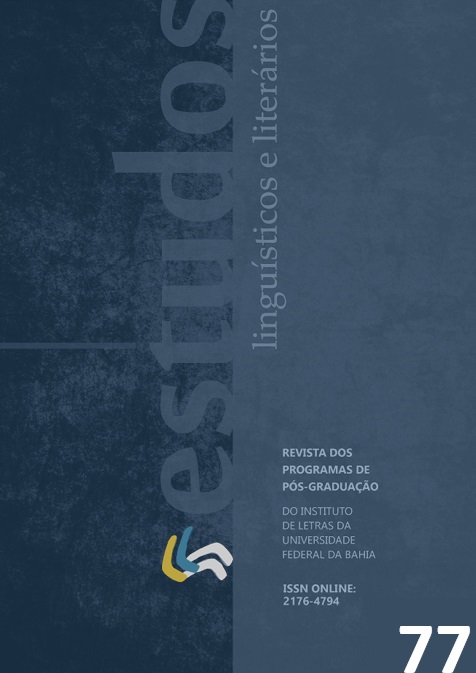FILLING THE PRE-VERBAL POSITION IN THE IMPERSONAL CONSTRUCTION WITH MODAL DAR
DOI:
https://doi.org/10.9771/ell.v0i77.61683Keywords:
Auxiliary modal dar; Abstract Case; Subject; Topic.Abstract
This squib intends to draw attention to the structure SN + dar para + Infinitive Clause, which has been shown to be unusual due to the fact that it presents the same linear configuration to the clause with the aspectual auxiliary dar, maintaining, however, the modality interpretation of possibility. The objective here is to understand why the NP moves to the left of the impersonal verb dar, whether due to a need for Case attribution (due to a weakening of verbal morphology (Nunes, 2015, 2016), or due to a tendency of BP to fill the pre-verbal position of sentences with phonetic content (Kato; Duarte, 2014; Ayres, 2021; Ayres; Othero, 2021). We assume that these NPs move from a Case position to occupy a topic position in the matrix clause. According to Nunes (2016), moving from an argument position to a non-argument position is completely licit, respecting the computational economy.
Downloads
References
AYRES, M. R. Contextos licenciadores de sujeitos nulos em português brasileiro. 2021. Tese (Doutorado em Letras) – Universidade Federal do Rio Grande do Sul, Porto Alegre.
AYRES, M. R.; OTHERO, G. A. Contexts for null subjects in contemporary Brazilian Portuguese. Revista Linguística, v. 17, p. 100-124, 2021.
BIBERAUER, T.; HOLMBERG, A.; ROBERTS, I.; SHEEHAN, M. Parametric Variation: Null Subjects in Minimalist Theory, Cambridge: CUP, 2010.
CHOMSKY, N. Derivation by phase. In: KENSTOWICZ, M. (Org.). Ken Hale: A Life in Language. Cambridge, MA: MIT Press, p. 1–52, 2001.
_____. Minimalist inquiries: The framework. In: MARTIN, R.; MICHAELS, D.; URIAGEREKA, J. (Orgs.), Step by Step: Essays on Minimalist Syntax in Honor of Howard Lasnik. Cambridge, MA: MIT Press, p. 89–155, 2000.
DUARTE, M. E. L. ReVEL na Escola: sobre pronomes pessoais na fala e na escrita. ReVEL, vol. 16, n. 30, 2018.
_____. O sujeito em peças de teatro (1833-1992): estudos diacrônicos. São Paulo: Parábola Editorial, 2012.
_____. Do pronome nulo ao pronome pleno: a trajetória do sujeito no português do Brasil. In: ROBERTS, I.; KATO, M. A. (Orgs.). Português brasileiro: uma viagem diacrônica. Campinas: Ed. da Unicamp, 1993.
DUARTE, M. E. L.; MARINS, J. Brazilian Portuguese: a ‘partial’ null subject language. Cadernos de Estudos Linguísticos, v. 63, 2021.
GORSKI, E. M. Emergência de dar pra/de no domínio funcional da auxiliarização modal deôntica. Fórum Linguístico, v. 17. n. 1, p. 4342-4356, 2020.
_____. Combinação de orações: gramaticalização de fenômenos co-ocorrentes. Letras de Hoje, v. 35, n. 3. p. 19-33, 2000.
HOLMBERG, A.; NAYUDU, A.; SHEEHAN, M. Three partial null-subject languages: a comparison of Brazilian Portuguese, Finnish, and Marathi. Studia Linguistica, p. 59–97, 2009.
KATO, M. A.; DUARTE, M. E. L. O sujeito no português brasileiro e sua tipologia. In: PILATI, E.; SALLES, H. L.; NAVES, R. (Orgs.) Novos olhares para a gramática do português brasileiro. Campinas: Pontes, 2017, p. 13-42.
_____. Restrições na distribuição de sujeitos nulos no Português Brasileiro. Veredas, v. 18, n. 1, p. 1-21, 2014.
KATO, M. A.; MARTINS, A. M.; NUNES, J. Português brasileiro e português europeu: sintaxe comparada. São Paulo: Contexto, 2023.
NUNES. J. Especificação morfológica de pronomes nominativos, concordância verbal e sujeitos nulos em Português Brasileiro. Fórum linguístico. v. 17, número especial, p. 4658-4672, 2020.
_____. Subject and topic hyper-raising in Brazilian Portuguese: A case study on reference sets for economy computations. In: KATO, M.; ORDOÑEZ, F. (Orgs.) The morfosyntax of Portuguese and Spanish in Latin America. Oxford: Oxford University Press, 2016, p. 107-134.
_____. Subespecificação de traços-φ e hiperalçamento no português brasileiro. In: FIGUEIREDO, C; ARAÚJO, E. (Orgs.). Diálogos com Ribeiro: sobre gramática e história da língua portuguesa. Salvador: EDUFBA, 2015, p. 121-148.
NURC. Projeto da Norma Urbana Culta Rio de Janeiro (NURC digital). Disponível em: https://nurcrj.letras.ufrj.br/. Acesso em: 15 out. 2020
NURC. Projeto da Norma Urbana Culta Recife (NURC digital). Disponível em: https://fale.ufal.br/projeto/nurcdigital/. Acesso em: 15 out. 2020.
OTHERO, G. A.; LAZZARI, M. Null subjects and null objects in Brazilian Portuguese: correlations and change. Revista de Estudos da Linguagem, v. 30, n. 4, 2022.
PIRES DE OLIVEIRA, R. A expressão ‘dar para/de Infinitivo’ em PB: uma análise formal. XLVIII Seminário do GEL. Assis, SP. Maio/2000.


